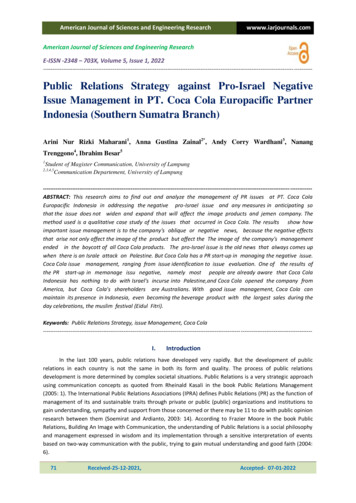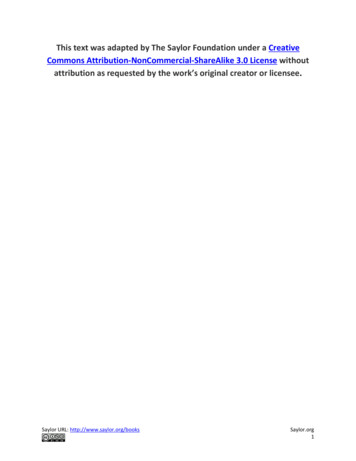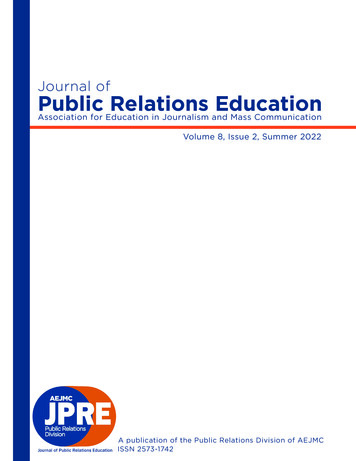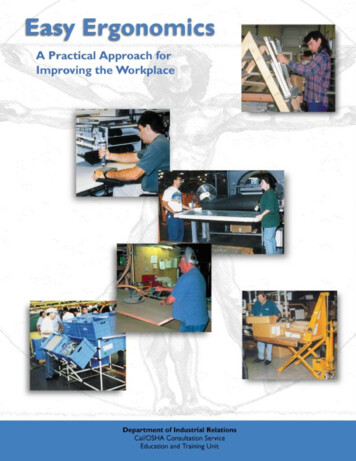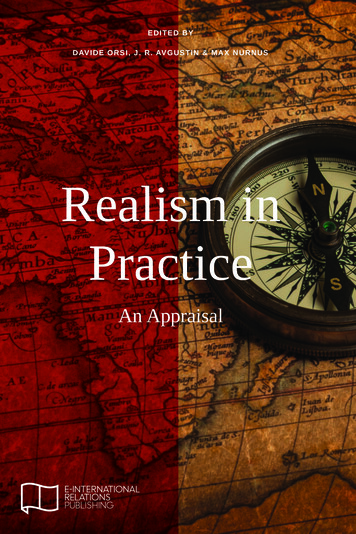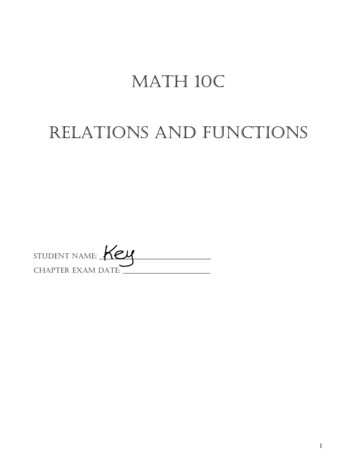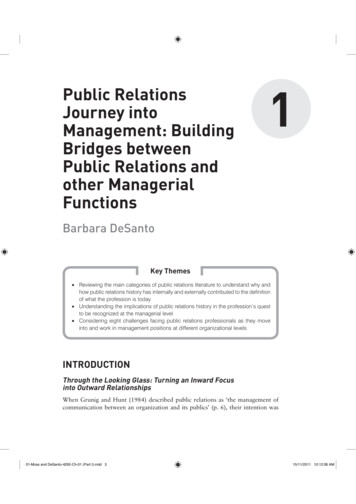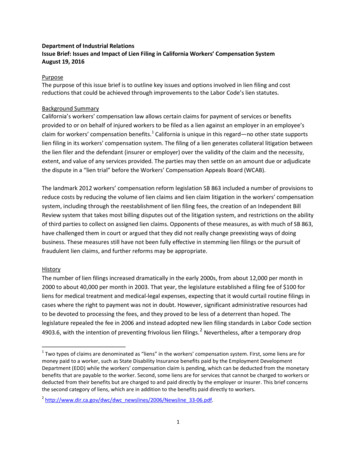
Transcription
Department of Industrial RelationsIssue Brief: Issues and Impact of Lien Filing in California Workers’ Compensation SystemAugust 19, 2016PurposeThe purpose of this issue brief is to outline key issues and options involved in lien filing and costreductions that could be achieved through improvements to the Labor Code’s lien statutes.Background SummaryCalifornia’s workers’ compensation law allows certain claims for payment of services or benefitsprovided to or on behalf of injured workers to be filed as a lien against an employer in an employee’sclaim for workers’ compensation benefits. 1 California is unique in this regard—no other state supportslien filing in its workers’ compensation system. The filing of a lien generates collateral litigation betweenthe lien filer and the defendant (insurer or employer) over the validity of the claim and the necessity,extent, and value of any services provided. The parties may then settle on an amount due or adjudicatethe dispute in a “lien trial” before the Workers’ Compensation Appeals Board (WCAB).The landmark 2012 workers’ compensation reform legislation SB 863 included a number of provisions toreduce costs by reducing the volume of lien claims and lien claim litigation in the workers’ compensationsystem, including through the reestablishment of lien filing fees, the creation of an Independent BillReview system that takes most billing disputes out of the litigation system, and restrictions on the abilityof third parties to collect on assigned lien claims. Opponents of these measures, as with much of SB 863,have challenged them in court or argued that they did not really change preexisting ways of doingbusiness. These measures still have not been fully effective in stemming lien filings or the pursuit offraudulent lien claims, and further reforms may be appropriate.HistoryThe number of lien filings increased dramatically in the early 2000s, from about 12,000 per month in2000 to about 40,000 per month in 2003. That year, the legislature established a filing fee of 100 forliens for medical treatment and medical-legal expenses, expecting that it would curtail routine filings incases where the right to payment was not in doubt. However, significant administrative resources hadto be devoted to processing the fees, and they proved to be less of a deterrent than hoped. Thelegislature repealed the fee in 2006 and instead adopted new lien filing standards in Labor Code section4903.6, with the intention of preventing frivolous lien filings. 2 Nevertheless, after a temporary drop1Two types of claims are denominated as “liens” in the workers’ compensation system. First, some liens are formoney paid to a worker, such as State Disability Insurance benefits paid by the Employment DevelopmentDepartment (EDD) while the workers’ compensation claim is pending, which can be deducted from the monetarybenefits that are payable to the worker. Second, some liens are for services that cannot be charged to workers ordeducted from their benefits but are charged to and paid directly by the employer or insurer. This brief concernsthe second category of liens, which are in addition to the benefits paid directly to workers.2http://www.dir.ca.gov/dwc/dwc newslines/2006/Newsline 33-06.pdf.1
Issues and Impact of Lien Filing in California Workers’ Compensation Systemfollowing the introduction of the Electronic Adjudication Management System (EAMS) online filingsystem in 2008, lien filings again rose through the end of the decade to as many as 34,000 per month.In 2010, the California Commission on Health and Safety and Workers’ Compensation (CHSWC) revisitedthe issue of why the number of liens was increasing again despite the reforms passed by the legislaturein SB 899 (2004). In its 2011 “Liens Report,” CHSWC found that “liens are both a cause and a result ofserious distress in the California workers’ compensation system.” The Commission found that in at leastone WCAB district office, liens consumed 35% of the court calendar and estimated that employers andinsurers were expending 200 million per year on loss adjustment expenses to handle medical liens.Further, it found that the “volume of liens forces the courts to encourage settlement, almost to thepoint of coercion. The necessity of settlement rewards both unjustified claims and unjustified refusals.” 3CHSWC documented a series of recommendations that were the basis for many of the lien-relatedadjustments included in the historic SB 863 reforms of 2012.SB 863 reinstated the lien filing fee and also enacted a new Labor Code section 4903.8 to address theassignment of liens by service providers to others in the business of filing and collecting on liens.Assigned liens were a particular problem in the system and fertile ground for presenting fraudulentclaims because they removed the dispute from the persons who actually provided or received theservices in question. They are especially prevalent in “denied claims,” that is, claims that an insurer hasalready rejected. In such cases, bills for treatment (real or imaginary) may be run up by a provider withno expectation of direct payment by the insurer, but then bundled and sold to a third party, who filesliens in an existing workers’ compensation case, sometimes well after the worker’s original case hasbeen resolved.Section 4903.8 requires that any order or award for payment of a lien be made only to the serviceprovider, unless an enforceable and irrevocable assignment was completed prior to January 1, 2013, orthe service provider has ceased doing business and has assigned all right, title, and interest in itsaccounts receivable to the assignee. Subdivision (b) of this section requires a true and correct copy ofthe assignment to be filed and served with the lien or within 20 days of the assignment. Subdivision (c)authorizes the WCAB to make a bad faith inquiry when there are multiple assignments of the same bill.Subdivision (d) requires the lien to be supported by a declaration under penalty of perjury by at leastone natural person who can attest to the fact that the services or products were provided. Subdivision(e) states: “A lien submitted for filing on or after January 1, 2013, . . . that does not comply with therequirements of this section shall be deemed to be invalid, whether or not accepted for filing by theappeals board, and shall not operate to preserve or extend any time limit for filing of the lien.”Although these provisions seem clear, they have proven difficult to enforce. Third-party filers haveomitted requisite information and paperwork regarding assignments when filing their liens through theEAMS system, effectively getting a foot inside the courthouse door and leaving it to defendants or the3California Commission on Health and Safety and Workers’ Compensation, “Liens Report,” January 5, 2011,accessed February 12, 2016, at https://www.dir.ca.gov/chswc/Reports/2011/CHSWC LienReport.pdf.2
Issues and Impact of Lien Filing in California Workers’ Compensation SystemDivision of Workers’ Compensation (DWC) to determine whether the filing was invalid because the lienwas assigned after January 1, 2013, or because the provider in fact was still in business. Tools areavailable for others to do this, including by reviewing statements and other reports filed with theSecretary of State that document the transfer and securing of accounts receivable; and DIR has beenable to find instances in which this occurred, but no record of assignment was included in thedocuments filed through EAMS. 4Case StudyReshealth Medical Group in Hermosa Beach, established as a corporation with the Secretary of State’soffice on August 14, 2013 (7½ months after the effective date of SB 863), ranks twelfth among medicallien filers in calendar years 2013 through 2015, with 4,696 medical liens filed for services totaling 21,479,325. In the case of Gituku v. Alta Home Care, WCAB Case No. ADJ 9178612, Javelin Three LLCfiled lien claims as the assignee of Reshealth, alleging that Reshealth had gone out of business as of thesummer of 2015. In a Decision After Reconsideration just issued on August 9, 2016, a panel of WCABcommissioners found that it was impossible to determine whether Reshealth (and another providerfrom whom Javelin had purchased accounts receivable) fell within either of the exceptions in Section4903.8 or whether the assignments in fact covered the subject bills, because the assignment contractsoffered into evidence were undated and incomplete. However, rather than rejecting the assigned lienclaims as invalid under subdivision (e) of section 4903.8, the WCAB punted the case back to a trial judgefor further proceedings to address these issues. 5One possible way to eliminate cases such as Reshealth would be to require lien filers to submit astructured standardized form to ensure that the requisite information is provided including: 1. date ofassignment; 2. indication that the lien is assigned, if applicable, and, if so; 3. to whom it is assigned andreject incomplete filings.The Power of DataAccess to data has refined our understanding of the issue. SB 863 has greatly enhanced DIR’s ability todetect fraud. Among other provisions, SB 863 instituted an independent medical review (IMR) system toresolve medical treatment disputes within the workers’ compensation system and mandated a numberof reforms in the lien filing system. By cross-referencing IMR filings with other data sources, including4DIR is reviewing a sample of high-volume lien filers from 2013-2015 that had filed accounts receivable with theSecretary of State to determine how many also had a record of the assignment in EAMS, as required by Labor Codesection 4903.8(b).5The lien claimants in this case also argued that section 4903.8 was not really a limitation on assignments, but justa requirement to award lien payments only to service providers who would then be free to turn the payment overto an assignee. Though correct in terms of the express requirements of subdivision (a) (“Any order or award . . .shall be made for payment only to the [original service provider]”), the problem underlying this argument, asexemplified in this case, is the seemingly entrenched cultural understanding or belief that concrete proof of anassignment and that services were actually provided is unnecessary unless and until someone presses the pointand maybe not even then.3
Issues and Impact of Lien Filing in California Workers’ Compensation Systemlien filings and provider billing data, we are now able to see patterns of behavior and billing amongindividual providers or groups of providers that might indicate fraud. This type of information was not soreadily detectable in the past. As our ability to capture and to analyze this data obtained through theIMR process, in combination with data available through other DWC, WCAB, and DIR sources, becomesmore robust, so, too, will our ability to detect fraud. DIR is evaluating and refining the methodologyused to measure outcomes by developing standardized reporting tools and identifying incentives toimprove behavior.DIR is also conducting ongoing data measurements and monitoring/reporting in the following specificareas to evaluate the effectiveness of actions taken.The top 1% of lien filers by volume on adjudicated cases between 2013 and 2015 discussed aboveincluded 68 businesses. Together, these entities filed 273,222 liens totaling 2.5 billion in accountsreceivable. Two of the business owners are currently under indictment, and three others have pledguilty.As noted in Figure 1, below, between January 2013 and May 2016, nearly 700,000 liens withaccompanying filing fees have been filed (for a total of nearly 104 million in new lien filing fees), as wellas nearly 114,000 liens that were exempt from filing fees. In the same period, over 461,000 previouslyfiled liens were activated through payment of a 100 lien activation fee (for total of 46 million).Figure 1. Monthly Lien Filings, 2013-2016Source: DWC EAMS Lien Filing System.4
Issues and Impact of Lien Filing in California Workers’ Compensation SystemFurther analysis of data in the lien filing system has revealed that 95% of the filings are in SouthernCalifornia, primarily concentrated (67%) in the Los Angeles basin (see Figure 2).Figure 2. Liens Filed in Q3 2015 by DWC Office Location (number)Source: DWC EAMS Lien Filing System.Most liens are filed for denied cases, which are not subject to utilization review to determine whetherthe treatment is reasonable and necessary. Filing dates suggest that lien claimants tend to wait untilafter the case-in-chief is settled, rather than seeking early resolution of medical necessity. In currentpractice, even if lien claimants (particularly those who bundle and buy/sell accounts receivable) onlymake pennies on the dollar, returns can still be high. Many of these liens are generated despite LaborCode section 4903.8’s restrictions on the assignment of lien claims, as shown in Figure 3.5
Issues and Impact of Lien Filing in California Workers’ Compensation SystemFigure 3. Diagram of Lien GenerationClear patterns emerge from an examination of lien claim data for the third quarter of 2015. For theperiod analyzed, 1,232 medical providers filed 76,756 medical and medical-legal liens with chargestotaling 714.6 million. Over 75% of the amount and volume of medical lien claims was attributed to thetop 10% of filers, primarily in radiology, pharmacy, and medical groups and centers.Impact on the CourtsThe volume and practices of lien filings have had a considerable impact on the workload and efficacy ofthe courts in the workers’ compensation system. The key issues include:1. Lien claimant litigation clogs the courts, and the court time devoted to these claims takes awayfrom the time available for injured workers.2. Injured workers have become a commodity used by medical providers and cappers. 63. Injured workers have been harmed and have even lost their lives due to incorrect andinappropriate treatment.4. Assignments allow for fraud and for the buying and selling of those injured workers’ treatment.5. Indicted providers use lien collection to finance their defense.6. Millions of dollars are spent every year on the oversight and regulation of medical treatmentbecause of the high prevalence of fraud in the system.6A capper is someone used to procure clients or patients. Insurance Code section 1871.1(a) states: “It is unlawfulto knowingly employ runners, cappers, steerers, or other persons to procure clients or patients to perform orobtain services or benefits pursuant to Division 4 (commencing with Section 3200) of the Labor Code or to procureclients or patients to perform or obtain services or benefits under a contract of insurance or that will be the basisfor a claim against an insured individual or his or her insurer.”6
Issues and Impact of Lien Filing in California Workers’ Compensation System7. Under our current laws, medical providers who have been convicted may still collect on theirliens at the WCAB.8. Because lien claimant representatives typically are not attorneys and are paid based on theamounts collected, the providers do not have to pay directly for representation. This placesdefendants who pay their own attorneys to defend these cases at a disadvantage and oftenmakes it more cost effective to pay or settle a fraudulent lien claim than to fight it.Potential SolutionsDIR has been working with stakeholders to identify potential solutions to these problems. Two ideashave been proposed to curb the nefarious behavior of a few providers that creates exorbitant costs andfriction for everyone in the system.1. Any physician or provider who has pled guilty or no contest to, or who has been convicted ofworkers’ compensation fraud, medical billing fraud, insurance fraud, or Medicare or MediCalfraud shall be barred from pursuing recovery on any workers’ compensation bill or lien.2. Liens filed by a physician or provider who is criminally charged with workers’ compensationfraud, medical billing fraud, insurance fraud, or Medicare or Medi-Cal fraud shall beautomatically stayed pending the disposition of criminal case.Estimated Inappropriate Costs to SystemIf the provisions identified as potential solutions above were to be adopted, the system-wide costavoidance could be substantial.7
Issues and Impact of Lien Filing in California Workers’ Compensation SystemTable 1. Totals for Liens Filed by Parties Indicted and/or Convicted, 2011-2015, WCAB CasesTotal Liens: 579,787; Total Lien Amounts: 4,066,059,795Number(#)/Amount( )97,07980,532 508,210,86816,547Number of liens filed by indicted and/or convicted partiesNumber of liens in system filed by indicted partiesAmount ( ) of liens in system filed by indicted partiesNumber of liens in system filed by parties that either offered a plea or wereconvictedAmount ( ) of liens in system filed by parties that either offered a plea or 91,107,125were convictedPercent of all liens in system filed by indicted and/or convicted parties17%Total amount ( ) liens in system filed by indicted and/or convicted parties 599,317,993Sources: DWC Lien Filing System, data current as of August 11, 2016; various court sources onindictments, pleas, and convictions.As shown in Table 1, 17% of all liens in the system were filed by indicted or convicted parties to date.Importantly, the dollars tied to these liens totaled 599,317,993, which, if paid, would be an additionalcost to the system.8
claim for workers' compensation benefits. 1. California is unique in this regard—no other state supports lien filing in its workers' compensation system. The filing of a lien generates collateral litigation between the lien filer and the defendant (insurer or employer) over the validity of the claim and the necessity,
